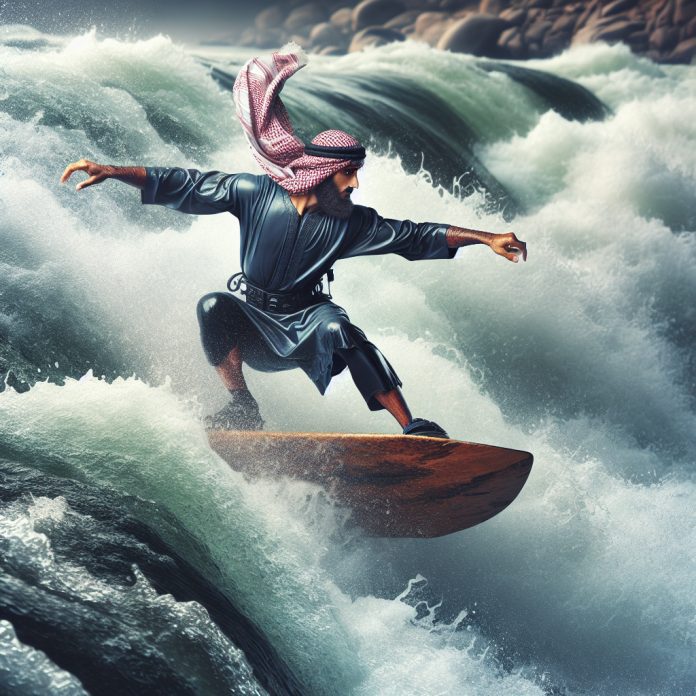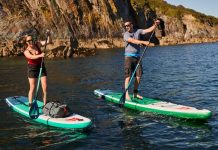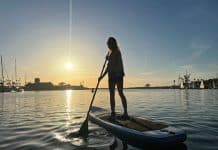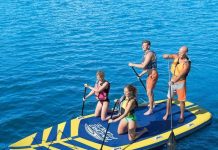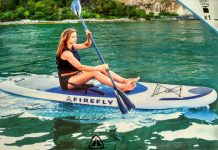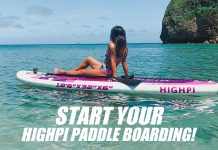Join us as we embark on an adrenaline-fueled adventure, riverboarding our way down raging rapids for the ultimate thrill. Strap on a buoyant board, equipped with fins and handles, and ride the waves as they crash and churn – an exhilarating experience that will leave you breathless and craving more. Experience the power of nature as you navigate through the twists and turns of the river, feeling the rush of the water against your body. Get ready to take the plunge into an extraordinary world of excitement and adrenaline as we explore the heart-pounding sport of riverboarding.
What is Riverboarding?
Riverboarding is an exhilarating water sport that involves riding down rapids on a specially designed riverboard. It offers a unique experience of gliding through fast-flowing rivers, navigating through obstacles and encountering varying levels of whitewater. Unlike traditional rafting or kayaking, which involve using paddles or oars, riverboarding relies on the use of body movement to control and maneuver the board. It is a thrilling adventure that combines aspects of surfing, bodyboarding, and river exploration.
Definition of Riverboarding
Riverboarding can be defined as the act of descending rapids on a buoyant board, usually made of fiberglass or inflatable materials, with the rider lying on their stomach and using their hands and feet to steer and control their movement through the water. It is a dynamic sport that requires physical strength, water skills, and a deep understanding of river dynamics.
Origin of Riverboarding
The origins of riverboarding can be traced back to the early 1970s when adventurous individuals in New Zealand and Australia started exploring new ways to navigate rivers. These pioneers experimented with different equipment and techniques, eventually developing the first riverboards to tackle their local whitewater. Over time, riverboarding gained popularity and began to spread to other parts of the world, becoming a recognized and respected water sport.
Riverboarding Equipment
To enjoy riverboarding to the fullest, it is essential to have the right equipment. The key piece of equipment is the riverboard itself, which comes in various shapes and sizes to suit different conditions and rider preferences. There are hydrodynamic riverboards, designed for speed and maneuverability, and inflatable riverboards, known for their durability and portability. Some enthusiasts even opt for custom-made riverboards tailored to their specific needs and riding style.
In addition to the board, riverboarders also need safety gear such as a helmet, personal flotation device (PFD), wetsuit or drysuit, fins, and protective footwear. These items not only provide protection but also enhance performance and comfort in the water. It is important to invest in high-quality equipment and regularly inspect and maintain it to ensure optimal safety and performance on the river.
The Thrill of Riverboarding
Riverboarding offers a unique and exhilarating experience that captivates adventure seekers and water sports enthusiasts. It provides an adrenaline rush, a feeling of freedom, and an intense physical experience that is unmatched by other activities.
Adrenaline Rush
Riding down rapids on a riverboard undoubtedly delivers an adrenaline rush like no other. The rush comes from the combination of speed, turbulent whitewater, and the thrill of conquering challenging sections of the river. The constant flow of water rushing by and the unpredictable nature of the rapids create an exciting and heart-pounding adventure that leaves riders craving more.
Feeling of Freedom
One of the most appealing aspects of riverboarding is the sense of freedom it offers. As the river carries you downstream, you are in direct contact with the water, feeling its power and energy beneath you. You have the freedom to choose your path, navigate around obstacles, and make split-second decisions to keep yourself safe. The ability to go with the flow of the river and connect with the natural environment creates a liberating experience that is hard to find elsewhere.
Intense Physical Experience
Riverboarding is not only thrilling but also physically demanding. Maneuvering the riverboard requires the use of your entire body, engaging your core, arms, legs, and back muscles. Constantly adjusting body position, kicking to steer, and paddling to control speed require strength, endurance, and agility. It is a full-body workout that leaves you feeling both exhilarated and physically challenged.
Choosing the Right Rapids
When it comes to riverboarding, selecting the appropriate rapids is crucial for an enjoyable and safe experience. Understanding river classifications, determining your skill level, and considering specific factors related to riverboarding are essential in making informed decisions.
Understanding River Classifications
Whitewater rapids are classified on a scale ranging from Class I (easy) to Class VI (extremely challenging and dangerous). Class I and II rapids are suitable for beginners or those looking for a more relaxed experience, while Class III and IV rapids provide intermediate-level challenges. Class V and VI rapids are typically reserved for highly experienced and skilled riverboarders due to their intense nature and technical demands.
Determining Skill Level
Before embarking on a riverboarding adventure, it is important to assess your skill level honestly. If you are a beginner, it is recommended to start with easier rapids and gradually progress to more challenging ones as you gain experience and confidence. Taking lessons or joining guided trips led by experienced instructors can help you acquire the necessary skills and knowledge to safely navigate different rapids.
Considerations for Riverboarding
In addition to river classifications and skill level, there are other factors to consider when choosing rapids for riverboarding. Water flow, temperature, weather conditions, river features, and potential hazards all play a significant role in determining the suitability and safety of a particular section of river. It is essential to research and gather information about a river before attempting to ride it, ensuring you have a comprehensive understanding of its characteristics and potential risks.
Safety Measures
While riverboarding is an exciting and thrilling activity, safety should always be a top priority. Taking appropriate safety measures, using proper gear and equipment, possessing knowledge of first aid, and understanding risk assessment and rescue techniques are essential for a safe and enjoyable riverboarding experience.
Proper Gear and Equipment
Wearing the right gear and equipment is crucial for riverboarding safety. A well-fitting helmet protects the head from potential impacts with rocks or other objects. A personal flotation device (PFD) ensures buoyancy and helps the rider stay afloat in case of a fall or accident. A wetsuit or drysuit provides insulation and protects the body from cold water and weather conditions. Fins provide extra propulsion and control, while protective footwear offers grip and guards against sharp rocks. Investing in high-quality gear and regularly inspecting it for any damages or wear is essential for maintaining safety standards.
Knowledge of First Aid
Having basic knowledge of first aid is important for any outdoor activity, including riverboarding. Being able to administer basic first aid techniques in case of minor injuries or accidents can make a significant difference in the outcome of an incident. Understanding how to treat cuts, fractures, and hypothermia, and knowing when to seek professional medical help are essential skills for riverboarders.
Risk Assessment and Rescue Techniques
Assessing risks and having the ability to recognize potential hazards are crucial skills for riverboarders. Understanding river dynamics, recognizing dangerous currents, and being aware of potential obstacles or strainers (objects that can trap individuals underwater) are essential for making informed decisions while on the river. Additionally, learning proper rescue techniques, such as the rope throw, reaching assist, and defensive swimming, can prove invaluable in assisting oneself or others in emergency situations.
Learning Riverboarding Techniques
To fully enjoy the experience of riverboarding, it is important to learn and master proper techniques. From mastering basic body positioning to navigating rapids and reading the river, developing solid skills and knowledge is key to becoming a proficient riverboarder.
Mastering Basic Body Positioning
Proper body positioning is essential for stability and control while riverboarding. To maintain balance and navigate the rapids, one must learn to distribute body weight appropriately on the board, arch the back slightly, and engage core muscles. Positioning the arms and hands for effective paddling and steering techniques is also crucial. Mastering these foundational skills lays the groundwork for more advanced maneuvers and techniques.
Navigating Rapids
Successfully navigating rapids requires a combination of skill, judgment, and experience. It involves reading the river, understanding its flow patterns and features, and anticipating potential obstacles or hazards. Proper navigation techniques, such as using eddies (calmer areas of water behind rocks or other objects) to rest or regain control, efficiently ferrying across currents, and executing precise turns, are essential to maneuver safely through rapids.
Reading the River
Reading the river is an essential skill for any riverboarder. It involves observing the water’s movement and characteristics to make informed decisions about the best route, potential obstacles, and areas of higher or lower flow. Understanding features such as waves, eddies, and boils, as well as identifying changing currents and undertows, allows riverboarders to choose the most advantageous path and avoid potential dangers. Reading the river becomes more intuitive with experience and is a crucial aspect of riverboarding safety and enjoyment.
Benefits of Riverboarding
Riverboarding not only provides thrilling experiences but also offers numerous physical and mental benefits. Engaging in this unique water sport can improve overall fitness, enhance balance and coordination, and foster a stronger connection with nature.
Full-Body Workout
Riverboarding is a physically demanding sport that engages multiple muscle groups throughout the body. The constant paddling, kicking, and maneuvering required to control the board and navigate rapids provide an excellent cardio workout and strengthen core muscles, arms, and legs. The resistance provided by the flowing water adds an extra challenge and enhances muscular endurance, making riverboarding a full-body workout that improves overall fitness and stamina.
Improves Balance and Coordination
Maintaining balance and coordination are crucial aspects of riverboarding. The constantly shifting and dynamic nature of the river require a heightened sense of body awareness and control. Balancing on the board while adapting to changing river conditions helps improve proprioception and overall balance. Coordinating body movements, such as paddling, kicking, and adjusting body position, enhances motor skills and coordination. These skills developed through riverboarding can translate to improved performance in other physical activities and daily life.
Connects with Nature
Riverboarding provides a unique opportunity to connect with nature in a more intimate and immersive way. Being in direct contact with the water, feeling its power and energy, and witnessing the beauty of natural landscapes from a river’s perspective offer a profound connection with the environment. Riverboarding allows individuals to appreciate the natural world, its intricate ecosystems, and the importance of preserving and protecting our rivers and waterways for future generations.
Types of Riverboards
Riverboards come in various types and designs, each with its own advantages and purposes. Hydrodynamic riverboards, inflatable riverboards, and custom-made riverboards offer different features and capabilities to cater to the diverse needs and preferences of riverboarders.
Hydrodynamic Riverboards
Hydrodynamic riverboards are built for speed and maneuverability. They are typically made of fiberglass or composite materials that offer rigidity and durability. Hydrodynamic boards feature a sleek, streamlined shape that allows for precise control and quick adjustments on the water. These boards are designed to excel in faster-flowing rivers, offering a thrilling and dynamic riverboarding experience.
Inflatable Riverboards
Inflatable riverboards are popular among riverboarders due to their portability and versatility. These boards are made of durable PVC or rubber materials and can be easily inflated and deflated, making them convenient for transport and storage. Inflatable riverboards are generally more forgiving and less prone to damage, making them suitable for beginners or those who prefer a more relaxed riverboarding experience. With advances in technology, inflatable riverboards now offer improved performance and stability, making them a viable option for riders of all levels.
Custom-Made Riverboards
For those seeking a personalized riverboarding experience, custom-made riverboards offer a tailored solution. Custom boards are designed to individual specifications, taking into account riders’ preferences, riding style, and specific river conditions. Custom riverboards can be built using a wide range of materials and designs, allowing for optimal performance and customization. While custom boards can be more costly, they offer the advantage of providing a board perfectly suited to an individual’s unique needs and preferences.
Riverboarding Communities and Events
Riverboarding has a dedicated community of enthusiasts around the world who gather to share their love for the sport and participate in various events and competitions. Riverboarding clubs, organizations, international competitions, and popular riverboarding destinations bring riverboarders together, fostering a sense of camaraderie and providing opportunities for skill development and friendly competition.
Riverboarding Clubs and Organizations
Riverboarding clubs and organizations serve as hubs for riverboarders to connect, share knowledge, and organize outings and trips. These communities provide a platform for beginners to learn from experienced riders, participate in training programs, and gain access to resources and information related to riverboarding. Joining a club or organization is a fantastic way to engage with like-minded individuals, expand your skills, and be part of a supportive community.
International Riverboarding Competitions
Riverboarding competitions showcase the skill and talent of riders from around the world, offering a platform for friendly competition and pushing the boundaries of the sport. These events bring together elite athletes and riverboarding enthusiasts to compete in various disciplines, such as freestyle, slalom, and downriver racing. Participating in competitions not only allows riders to test their abilities but also provides opportunities to learn from others and foster a sense of community within the riverboarding world.
Popular Riverboarding Destinations
Certain rivers and destinations have gained a reputation as prime spots for riverboarding due to their challenging rapids, scenic beauty, and infrastructure catering to the sport. Locations such as the Zambezi River in Africa, the Kaituna River in New Zealand, and the Colorado River in the United States are sought-after destinations for riverboarding enthusiasts. These destinations offer a range of riverboarding experiences, from mellow floats to adrenaline-pumping whitewater runs, attracting riders from all over the world.
Environmental Conservation
As riverboarders, it is crucial to respect and protect the rivers and natural environments that allow us to enjoy our sport. Embracing environmental conservation practices and supporting river conservation efforts is essential to ensure the continued availability and sustainability of riverboarding destinations.
Respecting the River Environment
Respecting the river environment involves adhering to Leave No Trace principles, minimizing our impact on ecosystems, and avoiding actions that may harm the river or its inhabitants. This includes not littering, properly disposing of waste, avoiding trampling on vegetation, and respecting wildlife and their habitats. By treating the river environment with respect and care, we contribute to the preservation of its beauty and ecosystem health.
Leave No Trace Principles
The Leave No Trace principles provide a set of guidelines for responsible outdoor recreation. These principles emphasize minimizing human impact on natural areas and promoting sustainable practices. Some key principles applicable to riverboarding include properly disposing of waste, staying on established trails, respecting wildlife, and minimizing campfire impacts. Adhering to these principles ensures that riverboarding activities have minimal negative effects on the environment.
Supporting River Conservation Efforts
Supporting river conservation efforts is vital for the long-term preservation of river ecosystems and the surrounding environments. This can be done by actively participating in cleanup initiatives, volunteering with local river conservation organizations, and contributing to river restoration projects. By supporting these efforts, riverboarders can give back to the rivers that provide them with so much joy, ensuring they remain pristine and accessible for future generations.
Riverboarding Tips for Beginners
For those new to riverboarding, here are some valuable tips to enhance your learning experience and keep you safe on the water.
Enroll in a Riverboarding Course
Taking a riverboarding course is highly recommended for beginners. Learning from experienced instructors allows you to acquire essential skills and knowledge in a structured and safe environment. Courses typically cover topics such as river safety, equipment usage, basic techniques, and river dynamics. By enrolling in a course, you can accelerate your learning curve, gain confidence, and develop a solid foundation for your riverboarding journey.
Start with Easy Rapids
As a beginner, it is important to start with easy rapids that suit your skill level. Gradually progress to more challenging rapids as you gain experience and confidence. Focus on developing core skills, such as body positioning, paddling, and navigating small waves and eddies. Starting with easier rapids allows you to build a strong foundation and gradually increase the complexity and difficulty of your riverboarding adventures.
Listen to Experienced Riverboarders
Listening to and learning from experienced riverboarders can provide valuable insights and advice. By tapping into the knowledge and experience of more seasoned riders, you can learn about river conditions, navigation techniques, and safety practices. Experienced riverboarders can offer guidance on gear selection, skill development, and how to make the most of your riverboarding experiences. Their wisdom and expertise can help accelerate your learning process and ensure a safe and enjoyable journey into the world of riverboarding.
In conclusion, riverboarding is a thrilling and dynamic water sport that offers tremendous excitement and adventure. From the adrenaline rush of riding rapids to the connection with nature and the physical challenges it presents, riverboarding provides a unique and unforgettable experience. By understanding river classifications, selecting appropriate rapids, taking necessary safety precautions, and continuously improving skills, riverboarders can immerse themselves in the wonders of the river and create lifelong memories. With a focus on environmental conservation and a supportive community, the future of riverboarding looks bright, offering endless opportunities for enthusiasts to explore new rivers, connect with fellow riders, and continue pushing the boundaries of this exhilarating sport.

